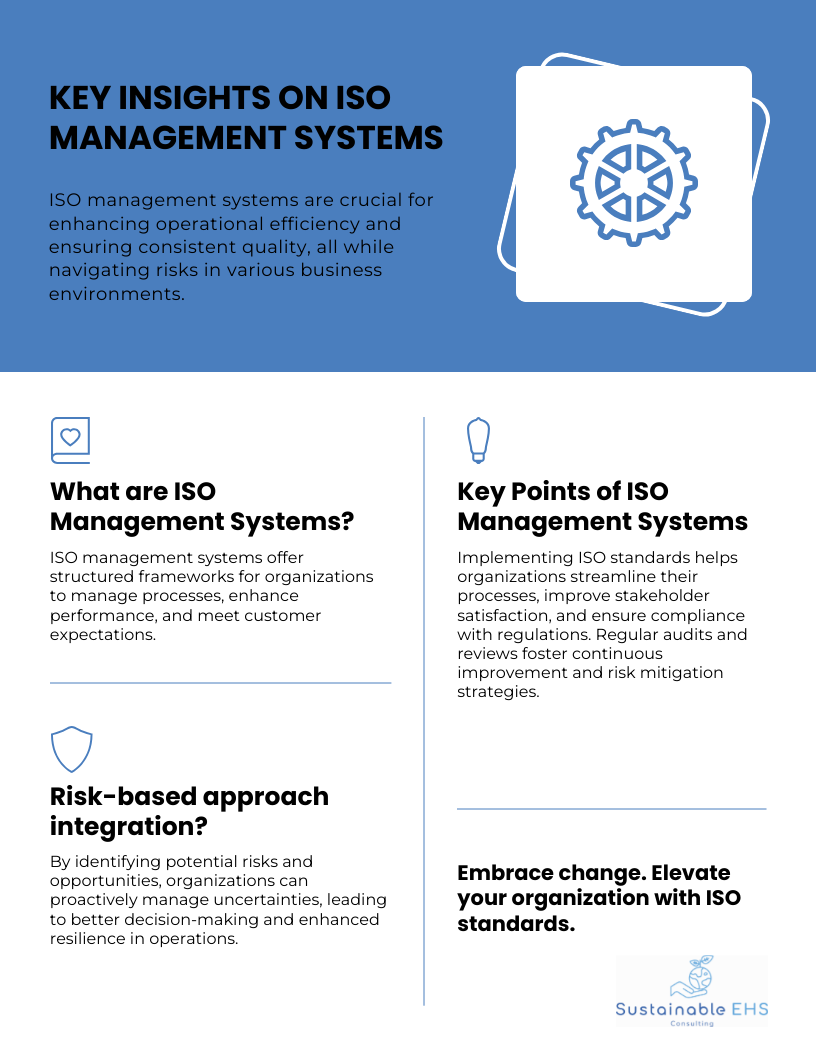Navigating Risks and Opportunities in ISO Management Systems
- barbaraderecka
- Mar 6
- 3 min read
Organisations are increasingly turning to International Organization for Standardization (ISO) management systems to enhance their operational efficiency, improve customer satisfaction, and maintain compliance with regulations. While adopting an ISO management system can seem like a formidable task, it ultimately empowers organisations to identify risks and seize opportunities for growth. In this blog post, we will delve into how risk and opportunities interconnect within ISO management systems and provide actionable insights for effectively managing them.
Understanding ISO Management Systems
ISO management systems are frameworks that help organisations manage their processes, quality, and compliance with external and internal standards. Popular ISO standards include ISO 9001 for quality management, ISO 14001 for environmental management, and ISO 45001 for occupational health and safety. Regardless of the standard used, the goal is the same: to foster continual improvement and sustainable practices.
The Risk Perspective
1. Risk Identification: One of the fundamental principles of ISO management systems is the identification of risks associated with organisational processes. This includes understanding internal factors (like inefficiencies) and external factors (such as regulatory changes) that can affect business performance.
2. Risk Assessment: Once risks have been identified, organisations must prioritize them based on their potential impact and likelihood of occurrence. This assessment is critical, as it guides the allocation of resources and the formulation of risk mitigation strategies.
3. Risk Mitigation: The ultimate goal is to minimize negative impacts on the organisation. ISO standards encourage organisations to document risk management processes, implement controls, and monitor risk over time. For instance, ISO 9001 emphasizes continual improvement, requiring organisations to regularly evaluate and update their risk management strategies.
The Opportunity Perspective
1. Leveraging Information: Organisations that effectively manage risks often find opportunities for improvement. Analyzing risk data can reveal process inefficiencies or gaps in service delivery, helping organisations to innovate and enhance their products or services.
2. Building Trust and Reputation: ISO certification showcases an organisation's commitment to quality and compliance. This transparency can strengthen customer trust and enhance brand reputation, opening doors to new markets and clientele.
3. Enhanced Employee Engagement: Engaging employees in the risk management process, such as encouraging them to report potential risks or suggest improvements, can cultivate a culture of ownership and accountability. This not only improves morale but often leads to innovative ideas and solutions.
4. Compliance and Competitive Advantage: Managing risks effectively can lead to better compliance with regulations and standards. Organisations can position themselves as industry leaders by exceeding compliance requirements, allowing them to stand out in saturated markets.
Best Practices for Managing Risks and Opportunities
1. Integrated Approach: Integrate risk management into existing business processes rather than treating it as a standalone initiative. Make risk management a part of every relevant meeting, report, and strategy discussion.
2. Engage Stakeholders: Engage employees at all levels of the organisation, as well as external stakeholders, to gain diverse perspectives on potential risks and opportunities. This inclusiveness fosters buy-in and collaboration.
3. Continual Improvement: Embrace the concept of continual improvement as prescribed by ISO standards. Regularly review processes and strategies to ensure they remain effective in managing risks while capitalizing on emerging opportunities.
4. Training and Development: Invest in training and development to ensure that employees understand the importance of ISO standards, risk management, and the potential opportunities that arise from effectively managing risks.
5. Leverage Technology: Utilize software solutions that track risk metrics and opportunities. Data-driven decision-making can enhance the effectiveness of risk management strategies and reveal insights that may not be immediately apparent.
Summary
ISO management systems serve as a catalyst for organisations to identify and navigate risks while seizing opportunities for improvement and growth. By integrating robust risk management practices into their operations, organisations can ensure that they are not just compliant but also competitive and innovative. Embracing ISO standards can help organisations turn the complexities of risk into pathways for success, making them resilient in a fast-changing world. Ultimately, the journey towards ISO certification and continual improvement is not just about managing risk; it's about transforming challenges into opportunities that foster growth and sustainability.




Comments